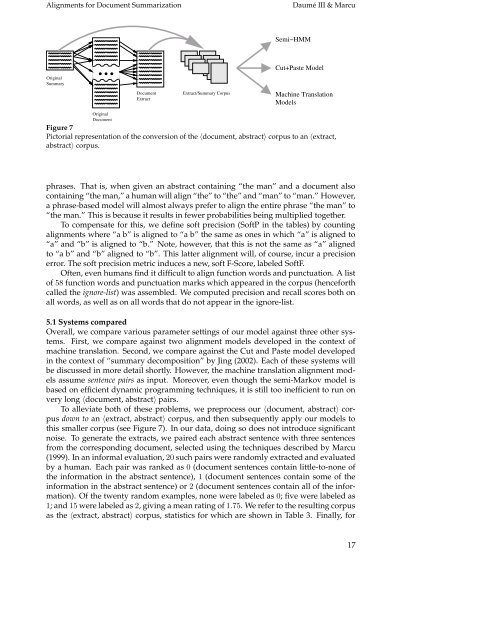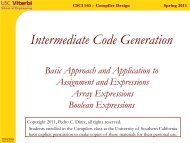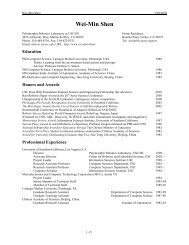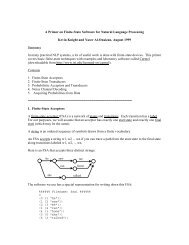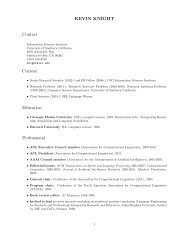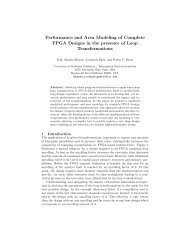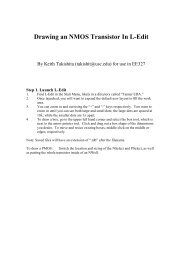Induction of Word and Phrase Alignments for Automatic Document ...
Induction of Word and Phrase Alignments for Automatic Document ...
Induction of Word and Phrase Alignments for Automatic Document ...
Create successful ePaper yourself
Turn your PDF publications into a flip-book with our unique Google optimized e-Paper software.
<strong>Alignments</strong> <strong>for</strong> <strong>Document</strong> Summarization Daumé III & Marcu<br />
Original<br />
Summary<br />
Original<br />
<strong>Document</strong><br />
<strong>Document</strong><br />
Extract<br />
Extract/Summary Corpus<br />
Semi−HMM<br />
Cut+Paste Model<br />
Machine Translation<br />
Models<br />
Figure 7<br />
Pictorial representation <strong>of</strong> the conversion <strong>of</strong> the 〈document, abstract〉 corpus to an 〈extract,<br />
abstract〉 corpus.<br />
phrases. That is, when given an abstract containing “the man” <strong>and</strong> a document also<br />
containing “the man,” a human will align “the” to “the” <strong>and</strong> “man” to “man.” However,<br />
a phrase-based model will almost always prefer to align the entire phrase “the man” to<br />
“the man.” This is because it results in fewer probabilities being multiplied together.<br />
To compensate <strong>for</strong> this, we define s<strong>of</strong>t precision (S<strong>of</strong>tP in the tables) by counting<br />
alignments where “a b” is aligned to “a b” the same as ones in which “a” is aligned to<br />
“a” <strong>and</strong> “b” is aligned to “b.” Note, however, that this is not the same as “a” aligned<br />
to “a b” <strong>and</strong> “b” aligned to “b”. This latter alignment will, <strong>of</strong> course, incur a precision<br />
error. The s<strong>of</strong>t precision metric induces a new, s<strong>of</strong>t F-Score, labeled S<strong>of</strong>tF.<br />
Often, even humans find it difficult to align function words <strong>and</strong> punctuation. A list<br />
<strong>of</strong> 58 function words <strong>and</strong> punctuation marks which appeared in the corpus (hence<strong>for</strong>th<br />
called the ignore-list) was assembled. We computed precision <strong>and</strong> recall scores both on<br />
all words, as well as on all words that do not appear in the ignore-list.<br />
5.1 Systems compared<br />
Overall, we compare various parameter settings <strong>of</strong> our model against three other systems.<br />
First, we compare against two alignment models developed in the context <strong>of</strong><br />
machine translation. Second, we compare against the Cut <strong>and</strong> Paste model developed<br />
in the context <strong>of</strong> “summary decomposition” by Jing (2002). Each <strong>of</strong> these systems will<br />
be discussed in more detail shortly. However, the machine translation alignment models<br />
assume sentence pairs as input. Moreover, even though the semi-Markov model is<br />
based on efficient dynamic programming techniques, it is still too inefficient to run on<br />
very long 〈document, abstract〉 pairs.<br />
To alleviate both <strong>of</strong> these problems, we preprocess our 〈document, abstract〉 corpus<br />
down to an 〈extract, abstract〉 corpus, <strong>and</strong> then subsequently apply our models to<br />
this smaller corpus (see Figure 7). In our data, doing so does not introduce significant<br />
noise. To generate the extracts, we paired each abstract sentence with three sentences<br />
from the corresponding document, selected using the techniques described by Marcu<br />
(1999). In an in<strong>for</strong>mal evaluation, 20 such pairs were r<strong>and</strong>omly extracted <strong>and</strong> evaluated<br />
by a human. Each pair was ranked as 0 (document sentences contain little-to-none <strong>of</strong><br />
the in<strong>for</strong>mation in the abstract sentence), 1 (document sentences contain some <strong>of</strong> the<br />
in<strong>for</strong>mation in the abstract sentence) or 2 (document sentences contain all <strong>of</strong> the in<strong>for</strong>mation).<br />
Of the twenty r<strong>and</strong>om examples, none were labeled as 0; five were labeled as<br />
1; <strong>and</strong> 15 were labeled as 2, giving a mean rating <strong>of</strong> 1.75. We refer to the resulting corpus<br />
as the 〈extract, abstract〉 corpus, statistics <strong>for</strong> which are shown in Table 3. Finally, <strong>for</strong><br />
17


